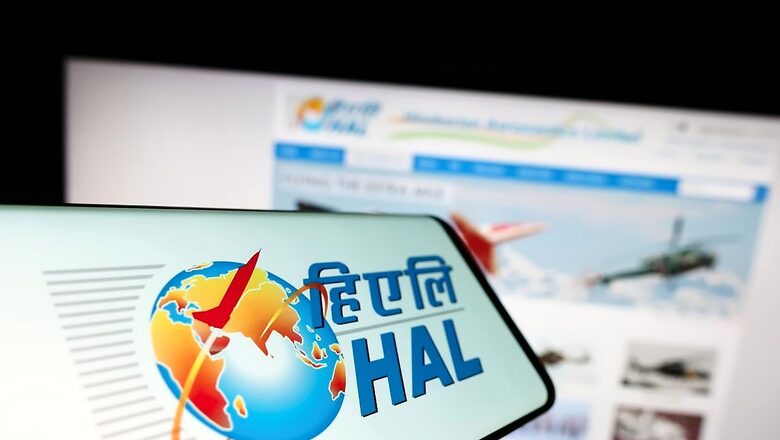
views
Hindustan Aeronautics Limited (HAL) is set to establish a Maintenance, Repair, and Overhaul (MRO) facility for the popular Airbus A320 family aircraft as part of its collaboration with the European aerospace giant. This move is aimed reportedly at supporting HAL’s “entry into the commercial aircraft servicing sector”.
Notably, Indian carriers Air India and Indigo have recently placed orders for 1,000 Airbus A320 planes, totalling over $120 billion in value for this year alone. In light of this, the Indian government, under Prime Minister Narendra Modi, has urged Airbus, Boeing, and other engine manufacturers to establish sourcing, MROs, and eventually final assembly lines in India.
This strategic push is proving to be successful as MRO plays a crucial role in the aerospace industry. India has also become the third-largest aviation market in the world, with the number of airports rising from 74 in 2014 to 147 in 2023. Currently, around 90 per cent of MRO requirements in India are fulfilled through imports, indicating significant growth potential for the domestic MRO sector.
Various companies are actively exploring opportunities to set up MRO facilities in India, with Rolls Royce and Safran, a French aviation engine maker, planning their respective MRO facilities in the country.
Air India Engineering Services Limited (AIESL) has already achieved a milestone by becoming the first MRO in the Indian subcontinent to conduct a 36-hour heavy check on a Boeing 737 MAX.
Rising global interest in India’s MRO sector is also an endorsement of the safety standards followed by India’s Directorate General of Civil Aviation.
As India’s aviation sector experiences robust growth, the Modi government is emphasising the development of indigenous manufacturing and repair facilities. This shift aims to bring tens of thousands of high-paying jobs and advanced industry skills to India, contributing significantly to the nation’s overall economic growth.
Need For MRO in India
With an order book exceeding 1,000 aircraft, India is poised to emerge as the world’s third-largest purchaser of commercial passenger planes, trailing only the United States and China. This surge in aircraft acquisitions is expected to generate a demand for 200–300 significant maintenance checks each year.
Furthermore, the ongoing replacement of ageing aircraft in various airline fleets opens up opportunities for MRO services to fulfill redelivery contracts. India’s trajectory toward becoming a substantial market for defense aircraft further amplifies the need for military MRO capabilities to meet the evolving demands of the aviation sector.
Establishing a mature MRO industry will not just create high paying jobs but also save billions in foreign exchange for India. It will also add a strategic advantage to India and its aviation industry.
Golden Opportunity Awaits
The worldwide aviation market is undergoing significant shifts in demand, aligning with structural changes in the global economic, demographic, and geopolitical landscape. These swift transformations are giving rise to imbalances, presenting opportunities to enhance the supporting ecosystem.
In this scenario, the maintenance, repair, and overhaul (MRO) sector finds itself with a substantial opportunity to bolster the aviation industry, and India is strategically positioned to surpass many established players.
In the realm of commercial aviation, the centre of growth is shifting from the traditional strongholds of Europe and North America towards Asia. Projections indicate that by 2040, Asia could accommodate half of the world’s global passengers, a significant increase from 37 per cent in 2021, and host 40 per cent of the global commercial aircraft fleet.
Focusing on India’s domestic market, it has achieved the status of being the third-largest domestic aviation market globally and is projected to surpass the UK, securing the position as the third-largest air passenger market by 2024. In FY20, India’s passenger traffic reached 341.05 million, experiencing a compound annual growth rate (CAGR) of 11.13 per cent from FY16 to FY20.
India’s defence purchases in aviation are also expanding owing to its burgeoning air force and overall firepower under the backdrop of heightened tensions with its northern neighbour China. There is a similar trend globally with the global defence aviation market projected to grow considerably, opening up opportunities for India to seize the day in the MRO business.
India’s yearly Maintenance, Repair, and Overhaul (MRO) revenue has the potential to triple, reaching $55-60 billion by fiscal 2028. This substantial growth, up from around $18 billion, is anticipated due to the overall expansion of civil aviation and supportive government initiatives, as indicated by Mumbai-based analytics group CRISIL Ratings.
According to Deloitte, the Indian MRO industry is expected to grow from US$ 1.7 billion in 2021 to US$ 4.0 billion by 2031, with an annual growth rate of 8.9 per cent, surpassing the global rate of 5.6 per cent. Meanwhile, according to Kearney, an American global management consulting firm, India is likely to generate a $7 billion MRO market across commercial and defense aviation by 2031. The sector is expected to create more than 90,000 jobs mostly in the aviation industry.
According to Jaideep Mirchandani, chairman of the United Arab Emirates-based aviation conglomerate Sky One FZE, India can be “the center for innovation in MRO capability globally.” “As the domestic fleet size increases to meet the demands, we expect a surge in MRO demand as it is a crucial support for any airline’s operations and safety,” he said on a TV news channel.
Push By Modi Government
The development of a domestic Maintenance, Repair, and Overhaul (MRO) infrastructure will not only assist airlines in optimising their aircraft operations but will also align with the government’s objective of establishing India as a prominent global aviation hub. HAL has positioned itself to trigger a sea change in favour of India in the MRO landscape of the world.
Established in 1940, HAL is one of the oldest as well as the largest aerospace and defence manufacturers in the world and has deep experience in the aerospace sector. HAL has impressively skilled manpower and its Nashik division already has capabilities in civil MRO services with the Directorate General of Civil Aviation (CGCA) approving three hangars.
CRISIL associate director Varun Marwaha said in a press release, “The [Indian] government has introduced several policies over [the] past year to realize its vision of making the country a global MRO hub.”
Notable initiatives include the reduction of Goods and Services Tax on MRO services from 18 per cent to 5 per cent, the shift to open tenders for land lease instead of predetermined rates to lower rental costs, the elimination of the 13 per cent royalty charged by government authorities on revenue, and the extension of land allotment to MRO service providers for 30 years as opposed to the current three to five years.
Simultaneously, construction activity has significantly taken off, with dedicated MRO facilities being established at Delhi and Bengaluru airports for select private airlines, and more facilities in progress. Plans are also in place for the setup of two MRO facilities near Jewar airport in Uttar Pradesh, and at the airports in Belagavi, Bhopal, and Tirupati in the states of Karnataka, Madhya Pradesh, and Andhra Pradesh, respectively.
NITI Aayog, the premier public policy think tank of the Indian government, has proposed a series of gradual measures to enhance the Maintenance, Repair, and Overhaul (MRO) sector in the country. The recommendations advocate the establishment of joint ventures with established global MRO players, with an initial emphasis on segments characterized by less stringent intellectual property control, such as electrical and electronics, avionics, and structural repair. The suggested approach involves a step-by-step progression up the value chain.



















Comments
0 comment